 EXHIBITOR @ EXPO 2010: EXHIBITOR @ EXPO 2010:
DAY NINE |
 |
|
| This simple use of projection inside the Japan Pavilion had us transfixed. A 3-D Japanese character protrudes from the wall as raindrops and snowflakes appear to fall upon and bounce off of it. |
|
| Japan featured an artistic live show that blended elements of traditional Chinese and Japanese theater with modern touches. The presentation tells the story of a pair of crested ibises. |
|
| Inside a lobby-like pre-show area, visitors file in and wait to enter the main theater. As they wait, a brief film called “Overture” is displayed on three large screens. This video is a slightly self-deprecating documentary-like compilation of clips that show American’s trying to welcome visitors to the USA Pavilion in Mandarin. |
|
| The second presentation, which includes messages from Secretary of State Hillary Clinton and President Barack Obama, features American children discussing their dreams for a better world alongside representatives from U.S. businesses outlining what they’re doing to make those dreams a reality. |
|
| The third presentation inside the USA Pavilion is a 4-D film that tells the story of a young girl who sets out to turn a blighted residential area into a park-like space. Without a single word of dialogue, it showcases how her infectious determination brings her community together to realize her goal. |
|
| This video is a brief interview with Greg Lombardo of BRC Imagination Arts, one of the design firms behind the USA Pavilion. In the video, Lombardo discusses the pavilion’s outreach program and why he thinks the project was so criticized by the American press. |
|
| This brief video shows the “Land” vignette inside the Australia Pavilion. The 51-foot-long exhibit was designed to change the stereotype of Australia from that of a rugged outback to that of a heavily urbanized country. It begins with a recreation of Australia’s famous Wave Rock formation, which melds into a giant acrylic wave, and ultimately transitions into a metal structure embedded with LED lights. |
|
| This video shows the presentation inside the Australia Pavilion, which features six massive screens that continually slide up and down on a revolving stage, offering a variety of visuals for the surrounding audiences. |
|
|
| Peter Sams, pavilion director and deputy commissioner-general for Australia, sits down with EXHIBITOR Magazine editor Travis Stanton to discuss the Australia Pavilion. |
Despite PR releases that claimed its pavilion was so much more interesting than India’s, Pakistan wouldn't let us inside. A staffer who looked and sounded like the Soup Nazi rudely shooed us away from the structure built to resemble the ancient Lahore Fort that the Mongols once destroyed.
We were almost as welcome — or unwelcome, rather — when we visited the Japan Pavilion. The PR dept did everything but demand our ritual suicide before letting us in. Even then, they wrapped our left arms with press credentials like water wings and hung a second identification around our necks. But it was worth it, to see staffers dressed like the endangered ibis — an endangered bird common to Japan and China which both countries have worked together to save — and the man-size robot that plays a violin as deftly as Itzhak Perlman. The Japanese Pavilion also featured an interesting live stage show that blended traditional Japanese and Chinese theater together and told the story of a pair of ibises in love. Nicknamed the Purple Silkworm Island following a contest held to find an unofficial moniker for the structure, the Japanese Pavilion’s unusual exterior is both eye catching and functional as it collects rainwater that is later used as brown water for various purposes.
More congenial if less hi-tech, the USA Pavilion showed what true exhibiting is all about. Despite critics almost universally hating on its box-your-printer-came-in design, the pavilion used a “student ambassador” program with about 180 young adults from the United States who spoke fluent Chinese. Compared to many pavilions staffed largely — if not exclusively — by Chinese, this subtle but significant difference put an approachable face on America and was extremely well received by visitors. The Pavilion also features a documentary-like compilation of film clips from celebrities like Kobe Bryant and Tony Hawk and scores of ordinary Americans that made the crowd laugh spontaneously with their less-than-Berlitz attempts to greet them in Chinese.
A second and third firm experience (emphasizing optimism and cooperation, themes that resonated beautifully with the mostly Chinese audience) brought more laughter — one of the few times we've heard that from a theater audience here at Expo — and a touch of awe when a small girl introduced Pres. Obama on film, who in turn received the audience of about 550 with a welcome in Mandarin. That moment — the elite and the common joined together — resonated heavily with this culture. (It was probably the third most politically astute gesture — after Macao's entire architecture referencing the year the Chinese reabsorbed them and the 12-year-old princess from the UAE welcoming visitors on a recorded video, in their language, informing them she'd been been studying Mandarin since the age of three. This is one country that knows where its future market will be.)
As schlocky as the corporate-sponsor area inside the USA Pavilion may appear to Americans, the Chinese audience gobbled it up with as much gusto as they do KFC: The hit of the area was a small podium built in the shape of the NY Stock Exchange. About 1,300 to 1,500 people line up per day for a photo op there, pretending to take part in the iconic scene where someone rings a bell or bangs a gavel to open the capitalist trading day. There were no gavels here, though — after the first 30 or so disappeared, the pavilion finally stopped restocking the display with them.
Maybe the gavels went where the pucks from the Czech Republic did. Lined with 65,000 of the little round items, the Czech Pavilion is slowly losing them to attrition and theft. Inside, anything worth stealing is pretty much nailed to the ceiling, where many of the 27 exhibits hang — from cubist furniture to a chandelier/projection screen made of found objects.
Australia is more than beer, but we didn't care after they sort of coughed in disbelief that by 6pm we still wanted to drink water. So, in the spirit of when-in-Rome, we shared a brew with the pavilion’s organizers after touring the Australian Pavilion, which is one of the most visually stunning pavilions of Expo 2010. Outside a large window in one of the VIP rooms (below another one with a $300,00 piano carved from 10,000 year old wood that's the color of peaches and cream), six carrot-shaped sculptures the length of an Amtrak car hang in an atrium-like setting, while two aerialists move back and forth. But that wasn't the sweetest eye candy. The 500-foot-long tunnel that winds around the structure carries you through a forest of aboriginal totems wired for sound, around an acrylic wave that pours over attendees, and into a presentation stage that literally drew gasps. Six massive screens continually slide up and down on a revolving stage, with each screen offering a different visual for the surrounding audiences. Even for someone bored by LED and unimpressed by Imax, it was an inspiring demonstration of how a presentation can arrest even the most jaded audience.
 |
 |
| click on the images for more info |
 |
 |
 |
 |
 |
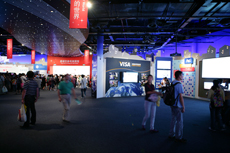 |
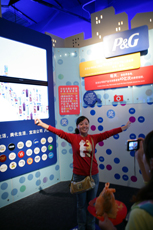 |
 |
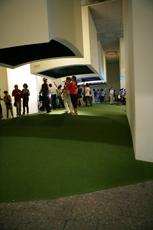 |
 |
 |
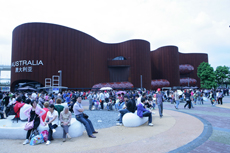 |
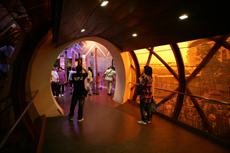 |
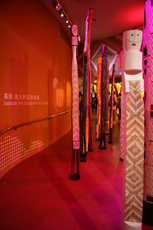 |
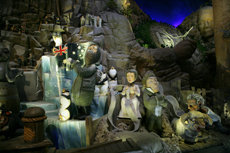 |
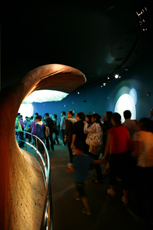 |
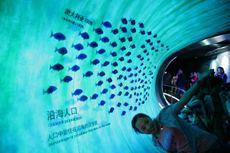 |
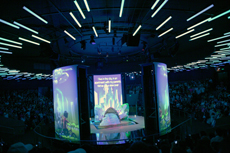 |
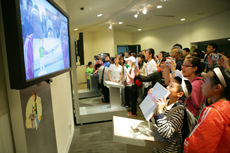 |
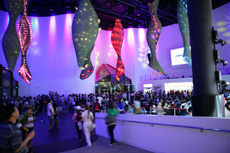 |
|
| |
| Top of Page |
|
|
